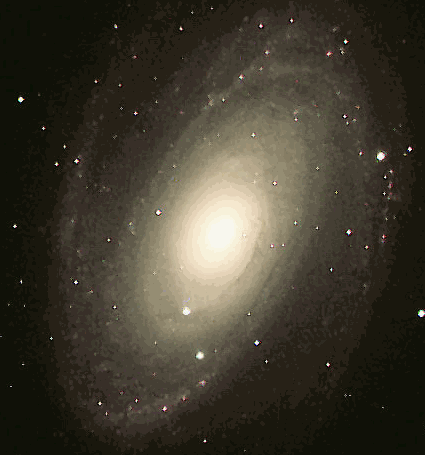This section will introduce how our
Milky Way galaxy
evolved. The subject of
galaxies themselves have
been left to the
Cosmology section. However, before astronomers
can understand how other
galaxies evolve, we must
study our own
galaxy.Theories of the evolution of
our galaxy - and any other - is under
continual refinement. Much of what we understand
about galactic formation is based on what we know
about
Dark Matter.
In a way, galactic formation is similar to
stellar formation, only on a much larger scale. With
the early Universe mixed with
Dark Matter and gases
containing molecular hydrogen, collisions eventually
occurred. Collisions led to conservation of energy
eventually resulting in collapse. There are two
methods of collapse:
-
Stars form early out of fragmentation,
resulting in shrinking and forming of elliptical
galaxies and
globular clusters
- Cloud shrinks faster resulting in rotation
of the cloud, then
star formation occurs
So for elliptical
galaxies,
stars formed
first. Spiral
galaxies like our
Milky Way formed
their
stars later - after the cloud began
rotation.
But what about the spiral structure?
The leading theory is that the spiral
structure of our
galaxy is a consequence of the
distribution of
OB Associations and hot
stars.
In addition, Density Waves are believed to
travel through the disk stimulating
star birth
in their wake.
Standard rotation does not explain the spiral
structure since the end result is what is called
the "winding problem."

(Image credit: Brooks/Cole Thomson Learning)
The spiral arms will overtake each other.
Here is an image that gives an example of the
density wave-OB Association (and hot
star)
theory of spiral structure.

This is a composite ultraviolet and infrared
image of M81. The infrared (shown in red) shows
the distribution of "normal"
stars. The blue
indicates the hot
OB type
stars.
Compare the above image with the true color
image below:

It is clear that the hot
OB type
stars are
tracing the spiral structure of the
galaxy. If
we could have a top-down view of our own
galaxy,
there is no doubt the view would be the same.
Much of what we learn about galactic formation
and evolution come from
computer simulations.
The study of
Dark Matter
and galactic formation
as well as the evolution of our
Universe all go
hand-in-hand - so stay tuned! Back
to Top |

